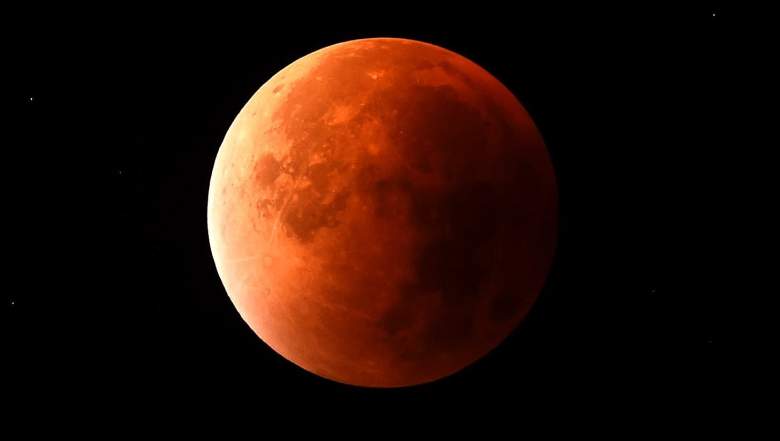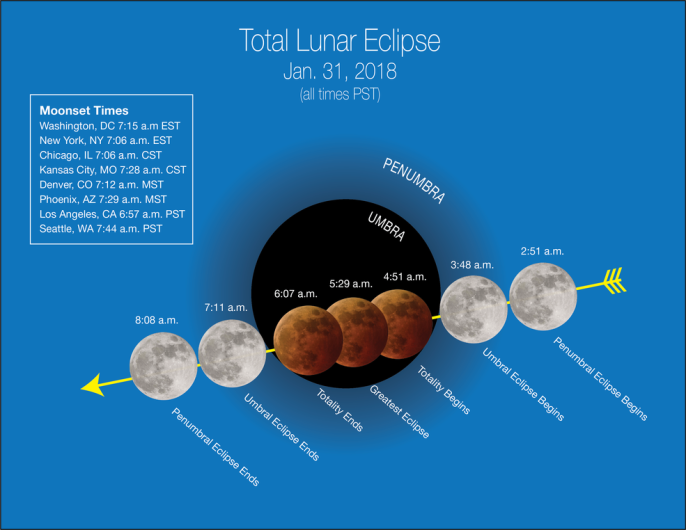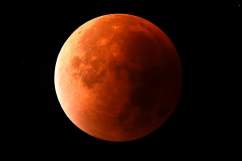
Getty Lunar Eclipse Blood Moon
We’re in for a treat during the early morning hours tomorrow, Wednesday, January 31. The super blue blood moon will be a coppery red full moon that appears slightly larger in the sky. It’s red because it’s a lunar eclipse, passing in the shadow of the Earth. You don’t want to miss this beautiful, rare sight. The last time we saw a lunar eclipse was in 2015. But unlike 2015, Wednesday’s won’t happen at night but in the early morning hours instead. So if you’re getting ready for work or sleeping, you might miss it. Here are the times that you should keep your eyes on the sky during the early morning hours, and how long the lunar eclipse will last. Be sure to look in the west-northwest direction and, if you can, try to be away from bright city lights.
If you’re in New York and other portions of the East Coast, the lunar eclipse (super blue blood moon) will start around 5:51 a.m. Eastern. The moon will enter the penumbra around 6:48 a.m. Eastern, but the moon sets at 7:06 a.m. Eastern, just a short time later. The penumbra is the when the moon moves into the Earth’s pale outer shadow. Sadly, this is around the same time that the sun is rising, so you won’t get a great view before the dawn takes over. The East coast will see a little of the lunar eclipse, but not the totality. In other words, the Eastern coast’s best time to see the moon is 6:45 a.m. Eastern, but you won’t see the totality before the sun rises.
If you’re in the midwestern part of the United States, the moon will enter the penumbra around 4:51 a.m. Central. It will enter the totality phase and start turning red around 6:15 a.m. Central. Your best views in the midwest will be between 6:15 and 6:30 a.m. local time, which is before the sun rises. In summary: Central time zone viewers (such as Kansas City or Chicago) will have a peak viewing time of 6:15-6:30 a.m, according to NASA. In the Texas region, peak viewing time will be around 6:51 a.m. with the moon setting at 7:24 a.m, according to KVUE.
If you’re in the Mountain states, the eclipse will begin around 4:48 Mountain time. But the red hue won’t be very visible until around 6:30 a.m. local time. The sun rises around 7 a.m., so you’ll get about 30 minutes of nice, red views. In summary: the Rocky Mountain region’s peak viewing is around 6:30 a.m. local time, for only 30 minutes until the moon sets.
The West Coast will have the best views of the lunar eclipse this time around. Yes, lucky West Coasters can see the entire lunar eclipse in all its stages before the sun rises. Technically, the eclipse will begin at 2:51 a.m. Pacific when the moon enters that pale shadow penumbra phase. But the umbral eclipse, when it starts to turn red, happens around 3:48 a.m. Eastern. The blood moon won’t enter totality, when it’s fully eclipsed, until 4:51 a.m. Pacific. It hits its peak at 5:30 a.m. local time, and ends at 6:07 a.m. So yes, if you’re on the west coast, you get to see everything. In summary, people in California and other parts of the west coast will get to see the entire lunar eclipse. Peak viewing is from 5-6 a.m. local time.

NASAPer Nasa: Stages of the Jan. 31, 2018 “super blue blood moon” (weather permitting) are depicted in Pacific Time with “moonset” times for major cities across the U.S., which affect how much of the event viewers will see. While viewers along the East Coast will see only the initial stages of the eclipse before moonset, those in the West and Hawaii will see most or all of the lunar eclipse phases before dawn.
If you’re in Australia or eastern Asia, you’re even luckier because you’ll get to watch the lunar eclipse on Wednesday night, without worrying about the sun interfering. And if you’re in Hawaii or Alaska, you’ll also get to see the eclipse from start to finish if weather permits.
If you miss Wednesday’s eclipse, the next lunar eclipse is July 27 of this year. So you won’t have to wait as long as you did after the 2015 lunar eclipse. Unfortunately, that one won’t be visible in the U.S. — you can only see it if you’re in Africa, the Middle East, or India. The United States won’t see another lunar eclipse until January 21, 2019, about a year from now.
